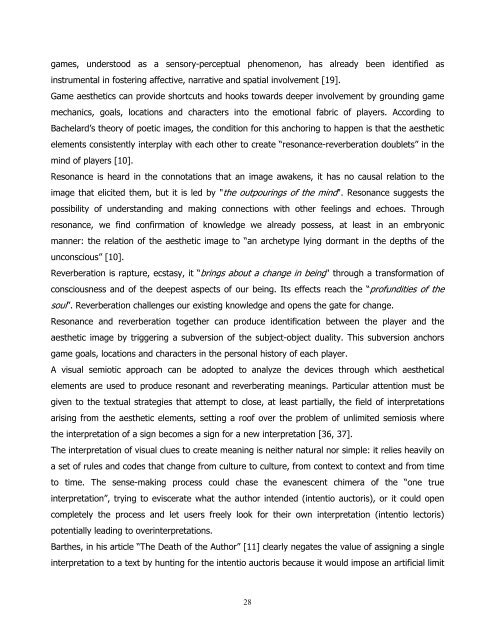Play-Persona: Modeling Player Behaviour in Computer Games
Play-Persona: Modeling Player Behaviour in Computer Games
Play-Persona: Modeling Player Behaviour in Computer Games
Create successful ePaper yourself
Turn your PDF publications into a flip-book with our unique Google optimized e-Paper software.
games, understood as a sensory-perceptual phenomenon, has already been identified as<br />
<strong>in</strong>strumental <strong>in</strong> foster<strong>in</strong>g affective, narrative and spatial <strong>in</strong>volvement [19].<br />
Game aesthetics can provide shortcuts and hooks towards deeper <strong>in</strong>volvement by ground<strong>in</strong>g game<br />
mechanics, goals, locations and characters <strong>in</strong>to the emotional fabric of players. Accord<strong>in</strong>g to<br />
Bachelard’s theory of poetic images, the condition for this anchor<strong>in</strong>g to happen is that the aesthetic<br />
elements consistently <strong>in</strong>terplay with each other to create “resonance-reverberation doublets” <strong>in</strong> the<br />
m<strong>in</strong>d of players [10].<br />
Resonance is heard <strong>in</strong> the connotations that an image awakens, it has no causal relation to the<br />
image that elicited them, but it is led by "the outpour<strong>in</strong>gs of the m<strong>in</strong>d". Resonance suggests the<br />
possibility of understand<strong>in</strong>g and mak<strong>in</strong>g connections with other feel<strong>in</strong>gs and echoes. Through<br />
resonance, we f<strong>in</strong>d confirmation of knowledge we already possess, at least <strong>in</strong> an embryonic<br />
manner: the relation of the aesthetic image to “an archetype ly<strong>in</strong>g dormant <strong>in</strong> the depths of the<br />
unconscious” [10].<br />
Reverberation is rapture, ecstasy, it “br<strong>in</strong>gs about a change <strong>in</strong> be<strong>in</strong>g" through a transformation of<br />
consciousness and of the deepest aspects of our be<strong>in</strong>g. Its effects reach the “profundities of the<br />
soul”. Reverberation challenges our exist<strong>in</strong>g knowledge and opens the gate for change.<br />
Resonance and reverberation together can produce identification between the player and the<br />
aesthetic image by trigger<strong>in</strong>g a subversion of the subject-object duality. This subversion anchors<br />
game goals, locations and characters <strong>in</strong> the personal history of each player.<br />
A visual semiotic approach can be adopted to analyze the devices through which aesthetical<br />
elements are used to produce resonant and reverberat<strong>in</strong>g mean<strong>in</strong>gs. Particular attention must be<br />
given to the textual strategies that attempt to close, at least partially, the field of <strong>in</strong>terpretations<br />
aris<strong>in</strong>g from the aesthetic elements, sett<strong>in</strong>g a roof over the problem of unlimited semiosis where<br />
the <strong>in</strong>terpretation of a sign becomes a sign for a new <strong>in</strong>terpretation [36, 37].<br />
The <strong>in</strong>terpretation of visual clues to create mean<strong>in</strong>g is neither natural nor simple: it relies heavily on<br />
a set of rules and codes that change from culture to culture, from context to context and from time<br />
to time. The sense-mak<strong>in</strong>g process could chase the evanescent chimera of the “one true<br />
<strong>in</strong>terpretation”, try<strong>in</strong>g to eviscerate what the author <strong>in</strong>tended (<strong>in</strong>tentio auctoris), or it could open<br />
completely the process and let users freely look for their own <strong>in</strong>terpretation (<strong>in</strong>tentio lectoris)<br />
potentially lead<strong>in</strong>g to over<strong>in</strong>terpretations.<br />
Barthes, <strong>in</strong> his article “The Death of the Author” [11] clearly negates the value of assign<strong>in</strong>g a s<strong>in</strong>gle<br />
<strong>in</strong>terpretation to a text by hunt<strong>in</strong>g for the <strong>in</strong>tentio auctoris because it would impose an artificial limit<br />
28















